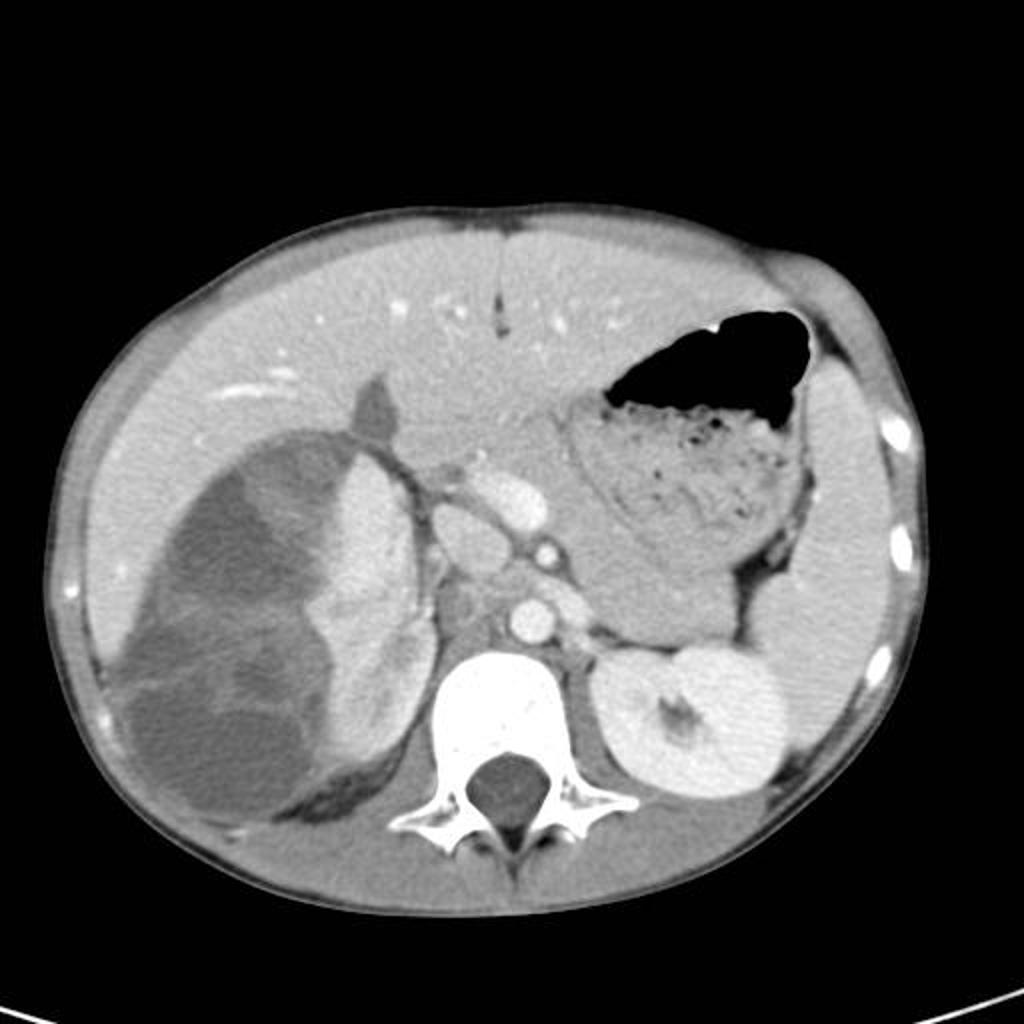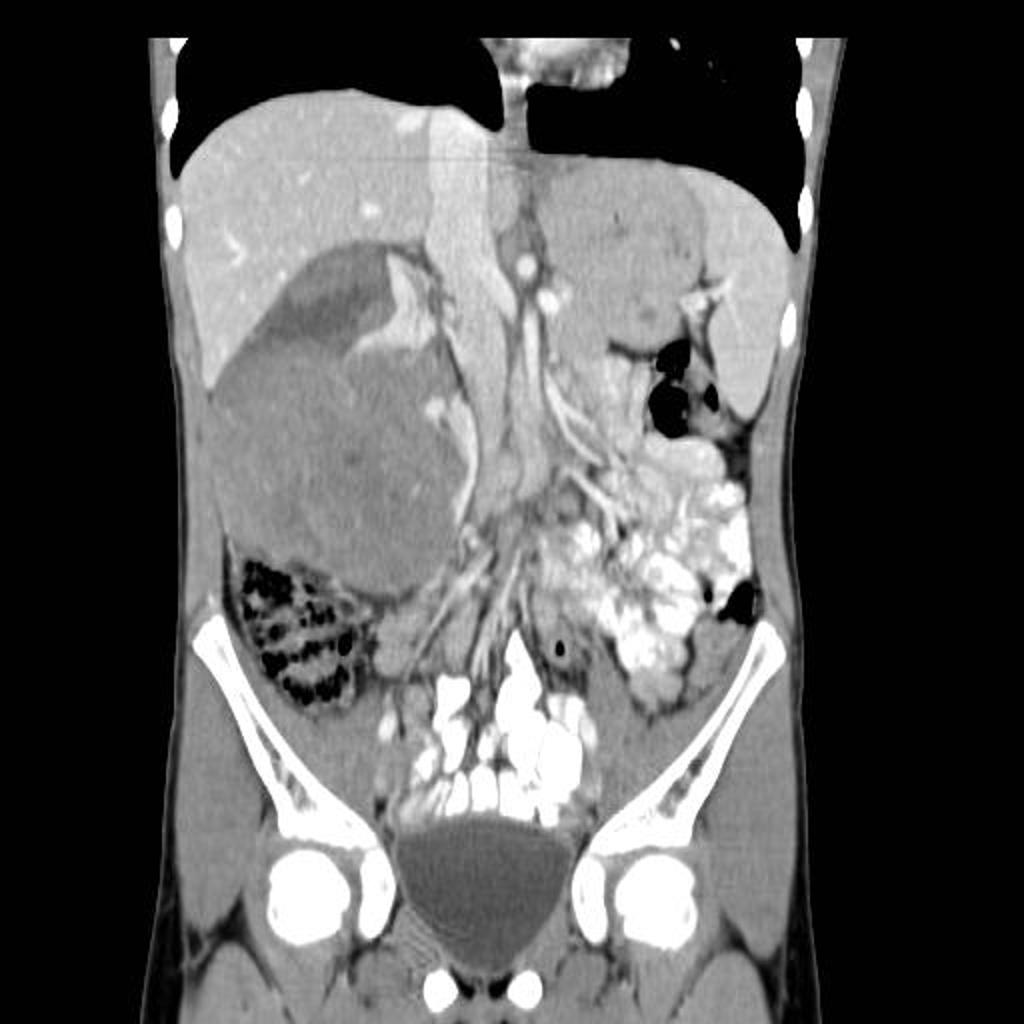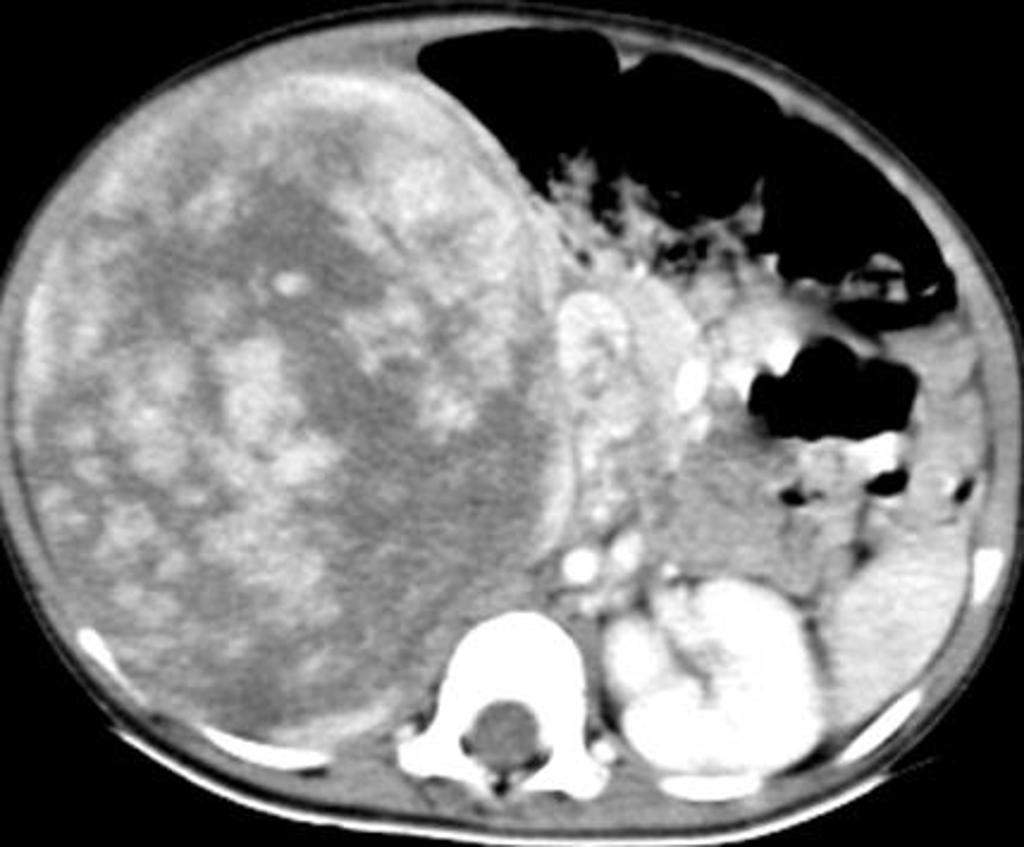Wilms' tumor CT: Difference between revisions
Jump to navigation
Jump to search
Sargun Walia (talk | contribs) (→CT) |
Farima Kahe (talk | contribs) No edit summary |
||
| (18 intermediate revisions by 3 users not shown) | |||
| Line 1: | Line 1: | ||
__NOTOC__ | __NOTOC__ | ||
{{CMG}} | {{CMG}};{{AE}}{{SSW}} | ||
{{Wilms' tumor}} | {{Wilms' tumor}} | ||
==Overview== | ==Overview== | ||
CT scan may be helpful in the diagnosis of | Abdominal [[CT scan]] may be helpful in the diagnosis of Wilms tumor.Findings on [[CT scan]] which can be suggestive of Wilms tumor include soft-tissue density masses, areas of [[calcification]] (~10%) and fat-density regions. [[CT]] is better than [[ultrasonography]] in detecting small lesions of tumor. [[CT scan]] of the chest can be helpful to diagnose [[Metastasis|lung metastasis]]. | ||
==CT scan== | ==CT scan== | ||
* Abdominal CT scan may be helpful in the diagnosis of | * Abdominal CT scan may be helpful in the diagnosis of Wilms tumor. Findings on CT scan suggestive of Wilms tumor include:<ref name="pmid4080660">{{cite journal |vauthors=Cahan LD |title=Failure of encephalo-duro-arterio-synangiosis procedure in moyamoya disease |journal=Pediatr Neurosci |volume=12 |issue=1 |pages=58–62 |date=1985 |pmid=4080660 |doi= |url=}}</ref><ref name="radio">Wilms tumour. Dr Tim Luijkx and Dr Frank Gaillard et al. Radiopaedia.org 2015.http://radiopaedia.org/articles/wilms-tumour </ref><ref name="pmid10813321">{{cite journal |vauthors=Gow KW, Roberts IF, Jamieson DH, Bray H, Magee JF, Murphy JJ |title=Local staging of Wilms' tumor--computerized tomography correlation with histological findings |journal=J. Pediatr. Surg. |volume=35 |issue=5 |pages=677–9 |date=May 2000 |pmid=10813321 |doi=10.1053/jpsu.2000.5941 |url=}}</ref> | ||
** Heterogeneous soft-tissue density masses | ** Heterogeneous soft-tissue density masses | ||
**These masses have frequent areas of calcification (~10%) and fat-density regions | **These masses have frequent areas of [[calcification]] (~10%) and fat-density regions | ||
* | **[[Lymph node]] [[metastasis]] | ||
* | **Invasion of surrounding organs | ||
* | **[[Thrombus]] in or occlusion of the [[renal vein]] and/or the [[inferior vena cava]] | ||
* | **Abdominal [[Lymph node|lymph nodes]] and contralateral involvement | ||
* | **Estimate tumor size and volume and to plan surgical management | ||
**Determine stage based on tumor size and structures involved | |||
* CT scan | *Chest CT scan can be helpful to diagnose [[lung]] [[metastasis]]. | ||
[[File:Wilms-tumour CT.jpg|center|thumb|300x300px|CT abdomen showing Wilms tumor | |||
Source:Radiopedia | |||
Case courtesy of Dr Jeremy Jones,<ref><nowiki>https://radiopaedia.org/cases/8084</nowiki></ref> | |||
]] | |||
<br clear="left" /> | <br clear="left" /> | ||
[[File:Wilms-tumour- coronal view .jpg|center|thumb|300x300px|Wilms tumor - coronal view | |||
source: radiopedia<ref>Case courtesy of Dr Jeremy Jones, <a href="https://radiopaedia.org/">Radiopaedia.org</a>. From the case <a href="https://radiopaedia.org/cases/8084">rID: 8084</a></ref> | |||
Case courtesy of Dr Jeremy Jones | |||
]] | |||
[[File:Wilms-tumour-4.jpg|center|thumb|300x300px|Wilms tumor - axial view | |||
source: Radiopedia - Case courtesy of Dr G Balachandran.<ref>Case courtesy of Dr G Balachandran, <a href="https://radiopaedia.org/">Radiopaedia.org</a>. From the case <a href="https://radiopaedia.org/cases/10250">rID: 10250</a></ref> | |||
]] | |||
==References== | ==References== | ||
Latest revision as of 15:24, 16 July 2018
Editor-In-Chief: C. Michael Gibson, M.S., M.D. [1];Associate Editor(s)-in-Chief: Sargun Singh Walia M.B.B.S.[2]
|
Wilms' tumor Microchapters |
|
Diagnosis |
|---|
|
Treatment |
|
Case Studies |
|
Wilms' tumor CT On the Web |
|
American Roentgen Ray Society Images of Wilms' tumor CT |
Overview
Abdominal CT scan may be helpful in the diagnosis of Wilms tumor.Findings on CT scan which can be suggestive of Wilms tumor include soft-tissue density masses, areas of calcification (~10%) and fat-density regions. CT is better than ultrasonography in detecting small lesions of tumor. CT scan of the chest can be helpful to diagnose lung metastasis.
CT scan
- Abdominal CT scan may be helpful in the diagnosis of Wilms tumor. Findings on CT scan suggestive of Wilms tumor include:[1][2][3]
- Heterogeneous soft-tissue density masses
- These masses have frequent areas of calcification (~10%) and fat-density regions
- Lymph node metastasis
- Invasion of surrounding organs
- Thrombus in or occlusion of the renal vein and/or the inferior vena cava
- Abdominal lymph nodes and contralateral involvement
- Estimate tumor size and volume and to plan surgical management
- Determine stage based on tumor size and structures involved
- Chest CT scan can be helpful to diagnose lung metastasis.



References
- ↑ Cahan LD (1985). "Failure of encephalo-duro-arterio-synangiosis procedure in moyamoya disease". Pediatr Neurosci. 12 (1): 58–62. PMID 4080660.
- ↑ Wilms tumour. Dr Tim Luijkx and Dr Frank Gaillard et al. Radiopaedia.org 2015.http://radiopaedia.org/articles/wilms-tumour
- ↑ Gow KW, Roberts IF, Jamieson DH, Bray H, Magee JF, Murphy JJ (May 2000). "Local staging of Wilms' tumor--computerized tomography correlation with histological findings". J. Pediatr. Surg. 35 (5): 677–9. doi:10.1053/jpsu.2000.5941. PMID 10813321.
- ↑ https://radiopaedia.org/cases/8084
- ↑ Case courtesy of Dr Jeremy Jones, <a href="https://radiopaedia.org/">Radiopaedia.org</a>. From the case <a href="https://radiopaedia.org/cases/8084">rID: 8084</a>
- ↑ Case courtesy of Dr G Balachandran, <a href="https://radiopaedia.org/">Radiopaedia.org</a>. From the case <a href="https://radiopaedia.org/cases/10250">rID: 10250</a>